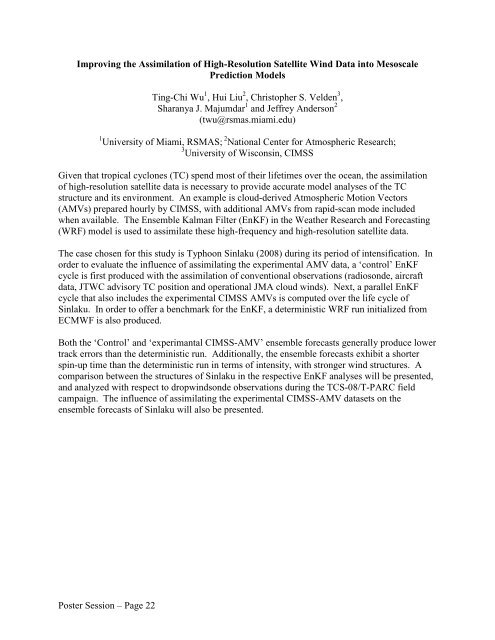65th IHC Booklet/Program (pdf - 4.9MB) - Office of the Federal ...
65th IHC Booklet/Program (pdf - 4.9MB) - Office of the Federal ...
65th IHC Booklet/Program (pdf - 4.9MB) - Office of the Federal ...
You also want an ePaper? Increase the reach of your titles
YUMPU automatically turns print PDFs into web optimized ePapers that Google loves.
Improving <strong>the</strong> Assimilation <strong>of</strong> High-Resolution Satellite Wind Data into Mesoscale<br />
Prediction Models<br />
Ting-Chi Wu 1 , Hui Liu 2 , Christopher S. Velden 3 ,<br />
Sharanya J. Majumdar 1 and Jeffrey Anderson 2<br />
(twu@rsmas.miami.edu)<br />
1 University <strong>of</strong> Miami, RSMAS; 2 National Center for Atmospheric Research;<br />
3 University <strong>of</strong> Wisconsin, CIMSS<br />
Given that tropical cyclones (TC) spend most <strong>of</strong> <strong>the</strong>ir lifetimes over <strong>the</strong> ocean, <strong>the</strong> assimilation<br />
<strong>of</strong> high-resolution satellite data is necessary to provide accurate model analyses <strong>of</strong> <strong>the</strong> TC<br />
structure and its environment. An example is cloud-derived Atmospheric Motion Vectors<br />
(AMVs) prepared hourly by CIMSS, with additional AMVs from rapid-scan mode included<br />
when available. The Ensemble Kalman Filter (EnKF) in <strong>the</strong> Wea<strong>the</strong>r Research and Forecasting<br />
(WRF) model is used to assimilate <strong>the</strong>se high-frequency and high-resolution satellite data.<br />
The case chosen for this study is Typhoon Sinlaku (2008) during its period <strong>of</strong> intensification. In<br />
order to evaluate <strong>the</strong> influence <strong>of</strong> assimilating <strong>the</strong> experimental AMV data, a ‘control’ EnKF<br />
cycle is first produced with <strong>the</strong> assimilation <strong>of</strong> conventional observations (radiosonde, aircraft<br />
data, JTWC advisory TC position and operational JMA cloud winds). Next, a parallel EnKF<br />
cycle that also includes <strong>the</strong> experimental CIMSS AMVs is computed over <strong>the</strong> life cycle <strong>of</strong><br />
Sinlaku. In order to <strong>of</strong>fer a benchmark for <strong>the</strong> EnKF, a deterministic WRF run initialized from<br />
ECMWF is also produced.<br />
Both <strong>the</strong> ‘Control’ and ‘experimantal CIMSS-AMV’ ensemble forecasts generally produce lower<br />
track errors than <strong>the</strong> deterministic run. Additionally, <strong>the</strong> ensemble forecasts exhibit a shorter<br />
spin-up time than <strong>the</strong> deterministic run in terms <strong>of</strong> intensity, with stronger wind structures. A<br />
comparison between <strong>the</strong> structures <strong>of</strong> Sinlaku in <strong>the</strong> respective EnKF analyses will be presented,<br />
and analyzed with respect to dropwindsonde observations during <strong>the</strong> TCS-08/T-PARC field<br />
campaign. The influence <strong>of</strong> assimilating <strong>the</strong> experimental CIMSS-AMV datasets on <strong>the</strong><br />
ensemble forecasts <strong>of</strong> Sinlaku will also be presented.<br />
Poster Session – Page 22
















